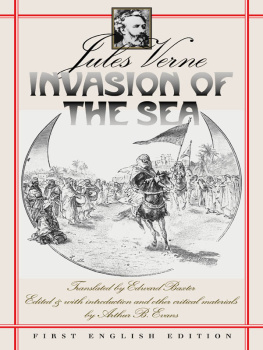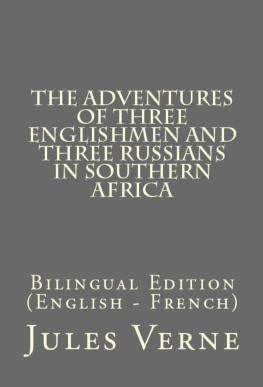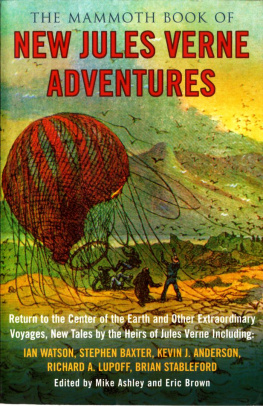
 INVASION OF THE SEA
INVASION OF THE SEA
THE WESLEYAN EARLY CLASSICS OF SCIENCE FICTION SERIES
GENERAL EDITOR ARTHUR B. EVANS


JULES VERNE
TRANSLATED BY EDWARD BAXTER
EDITED BY ARTHUR B. EVANS
INTRODUCTION AND CRITICAL MATERIAL
BY ARTHUR B. EVANS
Wesleyan University Press Middletown, Connecticut
Published by
Wesleyan University Press, Middletown, CT 06459
Translation copyright 2001 by Edward Baxter.
Introduction and notes 2001 Arthur B. Evans
All rights reserved
ISBN 0-8195-6545-8 paper
ISBN 0-8195-6465-6 cloth
Printed in the United States of America on acid-free paper
Designed by Rich Hendel and set into Cochin and Metropolitaine type by B. Williams & Associates
CIP data appear at the back of the book
5 4 3 2 1
 Introduction
Introduction
Closing the Circle: Jules Vernes Invasion of the Sea
As the first title to be published in Wesleyan University Presss new book series Early Classics of Science Fiction, this volume of Jules Vernes Invasion of the Sea is historically significant for many reasons. It is the first English translation of this important work,
Publishing History
LInvasion de la mer (1905, Invasion of the Sea) is one of four late novels by Jules Verne that have previously never been translated into English. The other untranslated titles from Vernes Voyages Extraordinairesa series comprising over sixty novels published from 1863 to 1919include Le Superbe Ornoque (1898, The Mighty Orinoco), Les Frres Kip (1902, The Kip Brothers), and Bourses de voyage (1903, Travel Scholarships). Unlike the recent discovery of his early unpublished manuscript of Paris au XXe sicle (1994, Paris in the Twentieth Century), these late works by Verne were never lost. Following their original French publication Yet, to date, they have never been available in English. Why?
The reasons for this perplexing lacuna have less to do with the quality of the novels themselves than with certain trends in the reading and publishing market of the late 1890s and early 1900s. In one sense, Verne was the victim of his own success. With the unparalleled triumph of his early best-selling novelsCinq semaines en ballon (1863, Five Weeks in a Balloon), Voyage au centre de la terre (1864, Journey to the Center of the Earth), De la terre la lune and Autour de la lune (1865 and 1870, From the Earth to the Moon and Around the Moon), Vingt mille lieues sous les mers (1870, Twenty Thousand Leagues under the Sea), and Le Tour du monde en quatre-vingts jours (1873, Around the World in Eighty Days)Verne achieved what no writer before him had succeeded in doing: he popularized a new brand of literature that mixed fiction with real science. This new literary genre, a forerunner of what would become known as scientifiction and then as science fiction in America during the 1920s, might be accurately described as scientifically didactic Industrial Age epic or, more simply (as the author himself chose to label it), le roman scientifiquethe scientific novel. With the worldwide success of his early romans scientifiques, Verne established a strong tradition for this innovative literary form, finally providing it with a socially acceptable institutional landing point and ideological model. Finally, the rapidly growing popularity of Vernes primary rival, H. G. Wells, had a major impact on the demand for Vernes fiction.
Undoubtedly, the huge success of H. G. Wellss scientific romances most adversely affected the sales of Vernes later works, especially among anglophone readers. After the publication of his 1895 and 1898 masterpieces, The Time Machine and The War of the Worlds, Wells was promptly acclaimed the English Jules Verne
English-language book publishers during the 1890s and early 1900s were unquestionably aware of and very sensitive to these market trends. Even in France, the demand for Vernes books had been slowly but inexorably diminishing during the final decade of his life, as he continued to churn out two or three novels per year. In contrast to the continuously sold-out print runs of thirty thousand to fifty thousand copies per title for Vernes earlier works between 1863 and 1880 (Le Tour du monde en 80 jours alone topped a hundred thousand), the first-edition sales of his later novels, from 1880 to his death in 1905, averaged only seven thousand to ten thousand each. The first printing of Le Superbe Ornoque in 1898, for example, was limited to a mere five thousandand unsold copies still remained in Hetzels stockroom Given these sales trends, it is understandable why British and American publishers might begin to be wary of offering their readers another new English translation of Vernes Voyages Extraordinaires.
But in addition to the factors of decreasing sales and a growing abundance of other Verne-like books in the marketplace, Anglo-American publishers also refused to publish many of Vernes later works on purely ideological grounds. As described by Vernian scholar Brian Taves:
By 1898, political questions had become the deciding factor in whether the latest Verne books were published in English at all. The tenor of his newer works were less agreeable to English-speaking audiences, or at least their publishers, who were not prepared to faithfully present Vernes views. The censorship grew beyond simply changing or removing controversial passages until eventually entire books were suppressed by simply not translating them into English. British publishers were fearful of offending their readers in the empire, and the anticipated taste of the British market largely governed what appeared on either side of the Atlantic. Although translations had been appearing with regularity to commercial success for a quarter century, a sudden change in policy was made. The Superb Orinoco became the first of Vernes annual books not to be translated, and thereafter few of his new works appeared in English.
As a result, of the seventeen Voyages Extraordinaires published in France after 1898, more than half were destined to remain untranslated into English until the late 1950s and 1960s (in severely abridged editions), and several have remained untranslated until the present day.
The Two Jules Vernes
Brief mention should also be made of the quality (or lack thereof) of the early English translations of Vernes works. It is now recognized that most English-language versions of Vernes Voyages Extraordinaires were very badly translated, and some were so bowdlerized that they bear little resemblance to the original French works. In a rush to bring Vernes potentially profitable stories to market, British and American translators often severely abridged them by deleting most of the science and the long descriptive passages (sometimes 20 to 40 percent of the original); they committed thousands of translating errors, both literary and technical; they frequently censored Vernes texts by either removing or adjusting passages that might be construed as anti-British or anti-American; and, in many cases, they actually rewrote Vernes novels to suit their own tasteschanging the names of principal characters, adding new scenes and episodes, reordering or relabeling the chapters, and so forth.
Next page









 INVASION OF THE SEA
INVASION OF THE SEA

 Introduction
Introduction